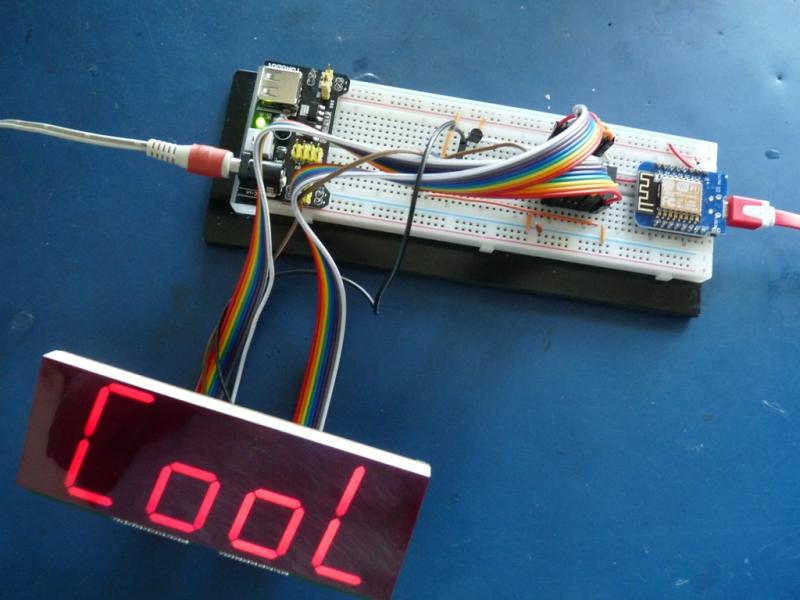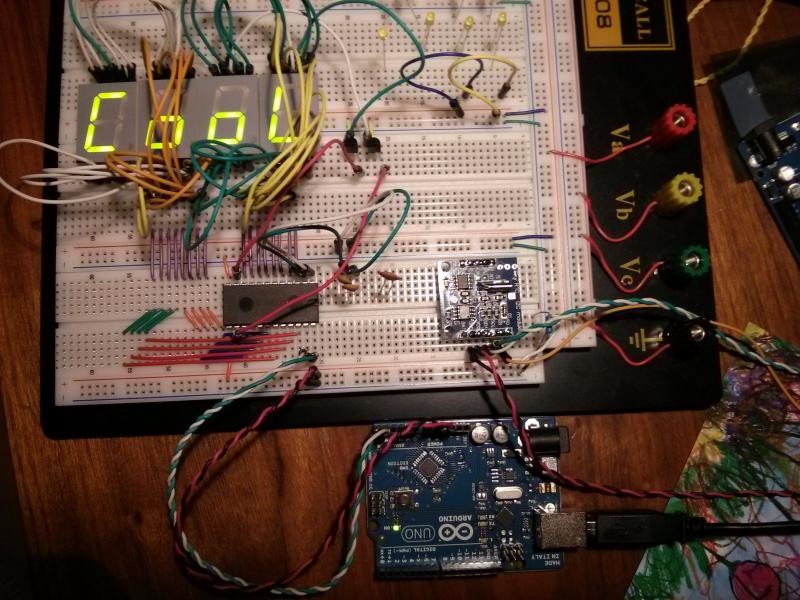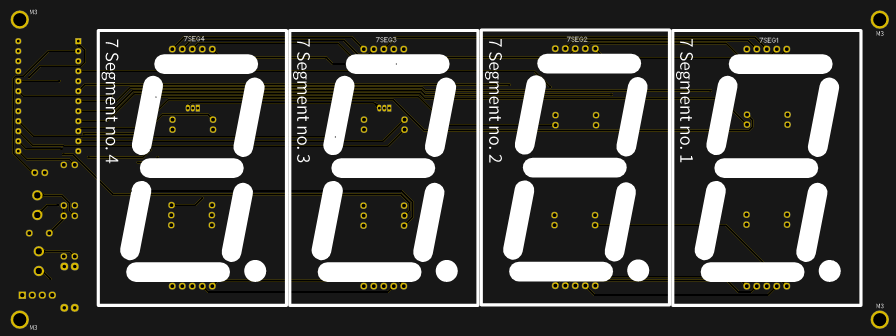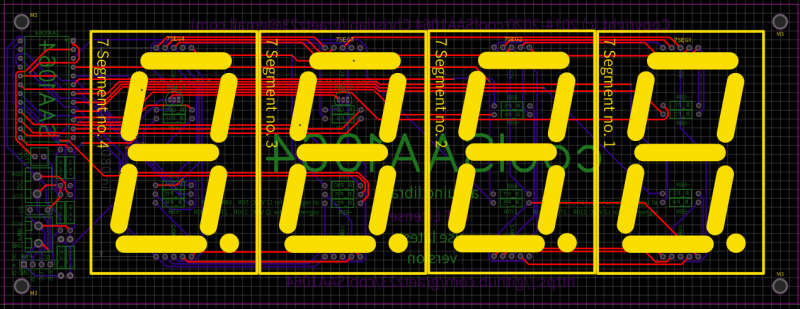The coolSAA1064 arduino library handles the 7 segment Philips / NXP SAA1064 driver.
The Philips / NXP SAA1064 drives up to four 7 segment displays via an i2c communication. The 7 segments have to have a common anode, otherswise you have to use a lot transistors. Anyway the huge advantage of the SAA1064 is, that it deals with up to 18 V of VCC, still driving a 5 V (max. 5.9 V) level on i2c wires. That allows for driving large 7 segments, that are internally built by four to six LED diodes, and need an break through voltage of about 8 V to 12 V. Top of the line, the SAA1064 can control the current of the segments, and makes diming possible.
In 2013 / 2014, I experimented with arduino, the real time clock module DS1307, and some need for output. It looked somehow like this:
The SAA1064 was still available and satisfied my need for output, but unfortunately there was no library for an easy way of using the SAA1064 available. So I (re-)structured, utilized, and object-oriented my SAA1064 code towards this arduino library implementation.
And in 2020 there's again the need for output. A friend of mine renovate some foosball (colored Germany vs. Brazil) and built in some photoelectric barrier to detect goals; he asked how to display a seven to one best. :-)
However the internet supported me several orange 7 segment displays with an alpha size of 2.3 inch (5.842 cm); that's a 7 seg of 6.97 cm x 4.78 cm. The problem arised how to wire 4 x 9 and 16 resistors, a DIL-24 socket for the SAA1064, and infrastructure, .. :-|
Therefore, I designed a PCB, where the 7 segments are on top, and all other parts are on the backside to encase it ..
Here is a link of dry running the PCB by the coolSAA1064 library with an arduino UNO. The 2.3" 7-segments are colored orange, the room is dark so it has some spectacular glowing effect. At the end the coolSAA1064 uses its text scrolling ability ..
Bake object and dry run segments
SAA1064 saa1064; // generate an object
saa1064.scollCooLSAA1064( ); // shows functionalitySet the brightness easily
saa1064.clear( ); // clean up all segments
saa1064.say( 8888 ); // switch all segments on
saa1064.setDark( ); // set output currents to 3 mA
saa1064.setNormal( ); // set output currents to 12 mA
saa1064.setBright( ); // set output currents to 21 mAor try the intensity in seven steps ..
saa1064.clear( ); // clean up all segments
saa1064.say( 8888 ); // switch all segments on
for( int i = 1; i < 8; i++ ) {
saa1064.setIntensity( i );
delay( 250 ); // wait
} // loopDisplay some number over all segment
saa1064.clear( ); // clean up all segments
saa1064.say( 5 ); // 5
delay( 250 );
saa1064.say( 15 ); // 15
delay( 250 );
saa1064.say( 815 ); // 815
delay( 250 );
saa1064.say( 2815 ); // 2815
delay( 250 );Display some number over all segment; fill front with zeros
saa1064.clear( ); // clean up all segments
saa1064.sayByZero( 5 ); // 0005
delay( 250 );
saa1064.sayByZero( 15 ); // 0015
delay( 250 );
saa1064.sayByZero( 815 ); // 0815
delay( 250 );
saa1064.sayByZero( 2815 ); // 2815
delay( 250 );Display some number by each segment
saa1064.clear( ); // clean up all segments
saa1064.say( 1, 0 ); // show 1 on 1st (id 0) digit
delay( 250 );
saa1064.clear( );
saa1064.say( 2, 1 ); // show 2 on 2nd (id 1) digit
delay( 250 );
saa1064.clear( );
saa1064.say( 3, 2 ); // show 3 on 3rd (id 2) digit
delay( 250 );
saa1064.clear( );
saa1064.say( 4, 3 ); // show 4 on 4th (id 3) digit
delay( 250 ); Say some time and date
saa1064.clear( ); // clean up all segments
delay( 250 );
saa1064.sayTime( 8, 5 );
delay( 250 );
saa1064.sayTime( 8, 15 );
delay( 250 );
saa1064.sayTime( 18, 15 );
delay( 250 );
saa1064.sayDate( 24, 01 );
delay( 250 );
saa1064.sayDateUS( 01, 24 );
delay( 250 );
saa1064.sayYear( 14 );
delay( 250 );
saa1064.sayYear( 2014 );
delay( 250 );Scroll time and date
saa1064.scrollTime( 18, 15, 00, 250 ); // right to left by 250 ms per step
saa1064.scrollDate( 15, 2, 2014, 250 ); // right to left by 250 ms per stepUse it as an amplitude
// amplitude in levels from 0 to 7
saa1064.clear( ); // clean up all segments
for( int i = 0; i < 8; i++ ) {
saa1064.amplitude( i );
delay( 125 );
} // loop
for( int i = 7; i >= 3; i-- ) {
saa1064.amplitude( i );
delay( 125 );
} // loop
for( int i = 3; i < 6; i++ ) {
saa1064.amplitude( i );
delay( 125 );
} // loop
for( int i = 5; i >= 0; i-- ) {
saa1064.amplitude( i );
delay( 125 );
} // loopPredefined words and letters
saa1064.clear( ); // clean up all segments
saa1064.sayFoo( ); // writes ' foo'
delay( 250 );
saa1064.saybAr( ); // writes ' bar'
delay( 250 );
saa1064.sayOn( ); // writes ' On'
delay( 250 );
saa1064.sayOFF( ); // writes ' OFF'
delay( 250 );
saa1064.sayGO( ); // writes ' gO'
delay( 250 );
saa1064.sayOPEn( ); // writes 'OPEn'
delay( 250 );
saa1064.sayLOAd( ); // writes 'LOAd'
delay( 250 );
saa1064.sayPLAY( ); // writes 'PLAY'
delay( 250 );
saa1064.sayDISC( ); // writes 'dISC'
delay( 250 );For more have a look at the coolSAA1064.ino and try running it.
And for more letters and their id have a look at the _init( ) method.
The most usable features of the library:
- select IC's internal test mode switching on all segments,
- select mode for two or four digits,
- select the intensity of the segments by dark, normal, bright,
- select the intensity of the segments by an integer 1 .. 7,
- display a number by 0 to 9999 as integer; blank not used,
- display a number by 0000 to 9999 as integer; not blanking,
- display hex values 0000 to FFFF as integer 0 .. 15,
- display letters by an interal code 16 .. following,
- display a digit as integer on a selected segment as update,
- display a digit as byte on a selected segment as update,
- display a digit on a selected segment as register update,
- display four digits seperately as integer or blank by -1,
- display four digits seperately as bytes,
- display one of a predefined word; CooL, Foo, bAr, ...,
- display a predefined smiley; 8-],
- display the time directly,
- display the date and the date in US and year,
- scroll any integer or internal codes by milliseconds per step,
- scroll time by 'hour-minute-second' from right to left,
- scroll date by 'day-month-year' from right to left,
- display an amplitude from right to left by an integer of 0 .. 7,
- display all possible letters that are stored internal,
- display all byte coding over all segments; takes time!
All necessary I2C communications are realized by only three methods:
- _set( .. ); // set the configuration of SAA1064; once implemented,
- _say( .. ); // tell bytes for displaying to SAA1064; two times implemented.
All other methods for communicating are using these two methods.
There are stable releases available by cloning or downloading and unzipping.
Everything was coded using:
- SAA1064 IC from NXP,
- 7 Segments displays; in German langugage only,
- arduino project,
- arduino IDE around 2014,
- arduino Makefile for automated building,
- atom editor,
- Gnome as window manager,
- and debian GNU/Linux.
have fun :-)
20230518
- updating copyright by year ..
20200414
- bug fix on added say word method; was in byte code not array index!
20200413
- released version v1.1:
- due to issue #1, the created setup() method for calling 'Wire.begin()',
- by version 1.1, call 'saa1064.setup()' in arduino's 'setup()'.
- released version v1.:
- added standard say mathods:
- sayOn, sayOFF, and sayGO,
- sayOPEn, sayPLAY, sayLOAd, and sayDISC.
- Therefore I
- moved '-' from id 26 to 27,
- moved ']' from id 27 to 28,
- moved '°' from id 28 to 29,
- added 'Y' to as id 26.
- moved _init() method to line 100 to fix it there for referencing,
- In honors to the discontinued SAA1064, rewritten readme, added pictures, examples, ..
- added standard say mathods:
20140215
- first stable implementation available.





